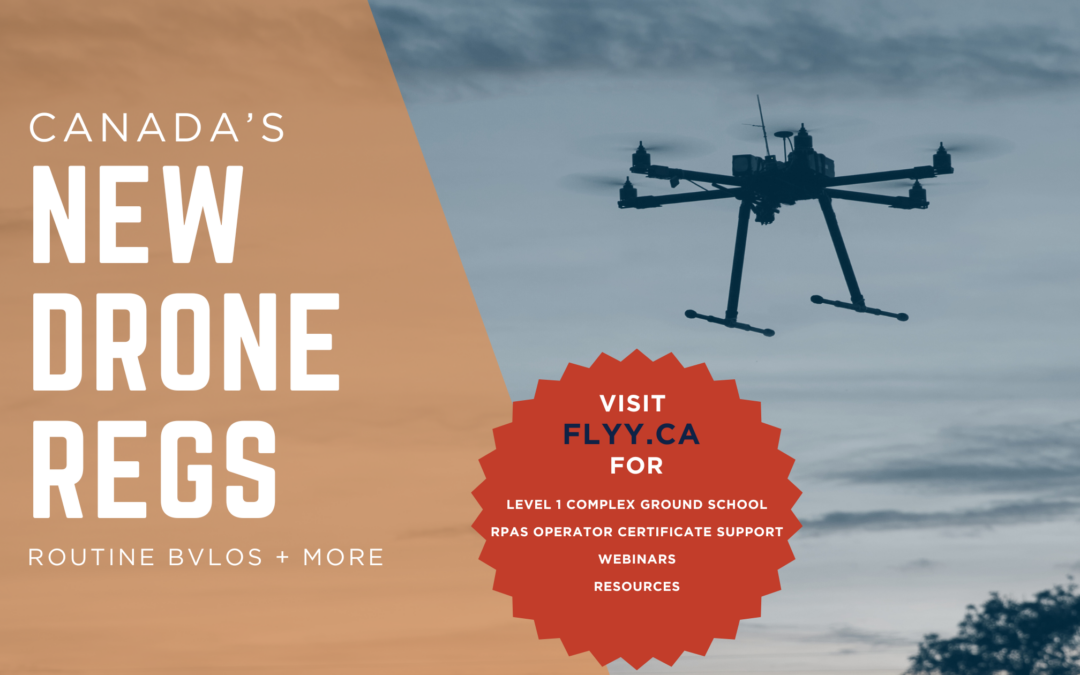It’s not every day I get excited to see an email before 6am but today was one of those days!
Unexpectedly, Transport Canada announced the publication of the highly anticipated Canada Gazette II which included new regulations for RPAS Operations Beyond Visual Line-of-Sight and Other Operations.
It’s a hefty publication with lots of cross-references but after a day of reading, re-reading and digesting, I’m pleased to provide this overview which we will continue to update as new information becomes available.
All-in-all, it’s what we were expecting and hoping to see with common sense amendments to existing regulations, noticeable inclusions from feedback on the Canada Gazette I draft, and formalization of the next phase of routine RPAS operations in Canada.
If you were one of the ones who took the time to provide comments to Transport Canada following CG1, well done. What we saw today is proof they listen and that those efforts matter. Thank you TC!
Some regulations come into effect on April 1 2025, with others waiting until November 4 2025. This phased approach enables the mechanisms for compliance to be in place prior to requiring compliance with them. In other words, it gives you time to get your stuff straight before it’s required by law.
So don’t panic. There are no major changes required before this flying season. You can’t even fly BVLOS under these rules until November.
What does these new rules mean for me as an RPAS pilot with…
…a microdrone?
- As of April 1 2025, if you wish to fly your microdrone at an advertised event, you’ll need a Special Flight Operation Certificate.
- On April 1, there are more regulations than just the CAR 900.06 “don’t be an idiot” rule that come into force that specifically spell out steps to follow if you inadvertently enter restricted airspace (CAR 900.07) and prohibitions around emergency security perimeters (CAR 900.08).
…a basic certification?
- Not many changes aside from general tidying of rules to ensure intent aligns with application
- You can allow a non-certified individual to fly under your supervision (CAR 901.54)
- You will be able to be a visual observer for BVLOS operations
- If you wrote the advanced exam but have your basic because you haven’t done the flight review yet, you are eligible to pursue your Level 1 Complex certification.
…an advanced certification?
- You get new capabilities as of November 4th! And you don’t have to do any additional testing or receive qualifications to take advantage of them!
- EVLOS – extended visual line of sight operations
-
- Allows you to fly up to 2NM from the pilot, control station and VO at any time during the flight, provided the pilot and control station are at the take-off and launch location (CAR 901.74)
- Sheltered Operation
-
- Allows the drone to be flown around a building or structure without the use of a visual observer, in accordance with certain conditions
-
- You can fly drones with an operating weight of up to 150kg
-
- With an advanced certification already in hand, you’ve met the prerequisite to begin your Level 1 Complex ground school (see the next section)
…an interest in routine, low-risk BVLOS?
- After November 4 2025, you’ll be able to fly low-risk BVLOS if you hold a Level 1 Complex RPAS pilot certification (CAR 901.89)
- What is low-risk BVLOS? (CAR 901.87) It’s BVLOS in uncontrolled airspace and away from people.
-
- the operation of a 250g – 150kg RPAS to conduct a BVLOS operation in uncontrolled airspace and 1 km or more from a populated area
-
- the operation of a 250g – 25kg RPAS to conduct a BVLOS operation in uncontrolled airspace over a sparsely populated area or at 1 km or more from a populated area
- In addition to holding a Level 1 Complex pilot certificate, you also need to be an RPAS Operator (RPOC) or an employee/agent of one and comply with the conditions of your certificate (CAR 901.88)
Will we be offering Level 1 Complex ground school?
YES. And more!
We have things well underway as we were hopeful and anticipating this announcement.
You can take advantage of our presale here to make sure you’re first in line once things become available.
Unlike previous ground schools, there are some requirements for the instructor that are required to be in place before we can even make the declaration to TC that we’re offering TP15530 compliant training. You can trust that we’re on top of it!
We are also working on training and other supports for organizations who intend to pursue their RPAS Operating Certificate (RPOC).
- Check out our free quiz here to see how ready your organization is for BVLOS operations.
- We also have a RPAS Operating Manual template available here, and will be updating it and the supporting guidance to remain in-line with Transport Canada expectations and industry best practices.
To follow Transport Canada’s rules around delivering this new course, a few things need to take place first.
- We need to appoint a Chief Ground Instructor
- The process to do so will be in place after April 1 and we’ll pursue it as quickly as we can.
- We need to ensure our content based on the draft TP15530 from CG1 is consistent with the TP15530 published on April 1.
- We need to make a declaration to the Minister in accordance with a standard that will be published April 1.
Following that, we will schedule dates for live-online delivery over a series of weeks on Wednesday mornings at 9:30 PDT for 2.5 hours. These sessions will be recorded and made available to all course participants to review or watch at their leisure.
Anticipated start date is before the end of April.
The Drone Site Selection Tool (DSST) will get updated to include new situational data layers for lower-risk BVLOS, such as
- population density
- aerodromes
- controlled airspace
- detect and avoid requirements
Check it out after April 1 2025 to see the new layers!
We’ll also see updates to NAV Drone this spring and again in the fall in support of these new operational capabilities.
Final Thoughts
- We still have time to process and time to act. There are no major changes happening before November 4th, though you’ll probably want to get your ducks in a row before then if you anticipate your flying season extending beyond that date.
- For maybe the first time ever, regulations have outpaced technology. We still (desperately) need technical detect solutions that are reliable, capable and affordable.
- Welcome to the next frontier in the evolving Canadian aviation ecosystem. We’re so glad you’re here with us.

